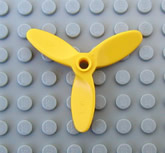APPLICATIONS OF THIS TECHNOLOGYMolecular switchesRotaxanes, as discussed earlier, can act as molecular switches, changing position depending on different factors. Thus specially designed rotaxanes can respond to different environments such as oxidation, reduction, light and pH. Some rotaxanes respond better to different environments eg. Azobenzene based rotaxanes respond well to light, and others can respond to many different influences. (above) An ant carrying a tiny computer chip! Ref 4a In other fields of nanotechnology, carbon nanotubes have been used to carry current and act a molecular wires. DNA has also been suggested as the base for a "biological" computer, and "quantum" computers have also been suggested. molecular mechanics (above) A propellor. Ref 4b Rotors made so far tend to use bulky aromatic groups extended from a central atom, which are able to spin, the alignment of these molecules creates a structure similar to that of a propellor. Gears can be made by using these large, typically flat structures to link with each other, however they much be carefully spaced. These could, potentially be activated using electron flow, in a similar fashion to rotaxane switches. However, some structures have been made that use catenanes as a "brake", that in the presences of eg a Cu+ ion, join together and stop the mechanism. Although these structures are still in their infancy, structures have been made using carbon nanotubes that mimic pistons, and also gears, and potentially biological rotors such as ATPase could aslo be utilised. |






